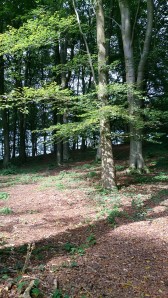“If Cadburye-Castle and Dolbury-Hill dolven were,
All England might ploughe with a golden sheere.”(Polwhele, 1816)
Dragons are the real stuff of stories and legends. Their image is repeated across the world from the powerful revered dragons of the East, that control water, floods and hurricanes, to the evil and cunning European dragons – the draco in Ancient Greek, Old Norse: dreki, and wyrm/wurm (meaning serpent or worm) in Old English and High Old German.
As a motif the dragon is an incredibly strong one, and in Britain our image of the dragon is drawn from the Anglo-Saxon, Norse, and Germanic sources that permeate into our collective understanding. Dragons portrayed as powerful hoarders, jealously guarding the treasures that it in fact has no use for. Scholars have argued that the occurrence of such an image in the Anglo-Saxon Poem Beowulf may represent the old order that had passed, for the dragon itself is reported to be “old and wise”.
The dragons could fly over the land, and were often associated with the bringing of ill fortune, as this from the Anglo-Saxon Chronicle suggests:
“In this year terrible portents appeared in Northumbria, and miserably afflicted the inhabitants: these were exceptional flashes of lightning and fiery dragons were seen flying in the air.”
Anglo-Saxon Chronicle (Year 793)
All of this serves as an introduction to a wonderful dragon story. For some dragons it seems, inhabiting one hillfort is not enough. Richard Polwhele (a nineteenth century Cornish clergyman and historian of Devon and Cornwall) tells the story as follows:
“Between those two [Cadbury and Dolbury] hills (you may be pleased to hear a pretty tale) that is said (I set not down wordes to lessen your belief of the matter,) but to let you know that, nil praeter auditum habeo.
Take yt on this condition, it holds credyt by tradition, That a fiery dragon or some ignis fatuus, in such lykeness, bynne often seene to flye between these hills, komming from the one to the other in the night season, whereby it is there is a great treasure hid in each of them, and that the dragon is the trusty trcaurer, and sure keeper thereof, as he of the golden fleece in Chalcos which Jason by the help of Medea brought thence…”¹
The two hills are Cadbury Castle, a multi-vallate Hillfort in Somerset dating from the late Bronze Age, and continued in use into the Roman period, and Dolbury, is a single ditched hillfort dating to the Iron Age. (Cadbury is also one of a number of sites in the South-West of England associated with being the location of Camelot, but that is for another time). Conveniently, whenever you visit one site, the Dragon is said to reside at the other (and incidentally the dragon is also said to protect Fursdons of Fursdon, a family and Estate near Exeter, as well as the two hillforts).
So what brought the dragon to this quiet part of the Devonshire and Somerset countryside?
One story tells us that the inhabitants of Dolbury appeased the god of harvest by leaving offerings down a well. Excavations at Cadbury have uncovered a well containing what are thought to be votive offerings. It is these offerings that lured the Dragon to the two hilltop locations. As the National Trust in their information at Killerton House (the grounds of which include Dolbury) point out, it more than likely the myth was propagated to protect these gifts to the gods.
But these aren’t the only hillforts to be associated with stories of dragon. For example, Dinas Emrys, a hillfort in Gwynedd North Wales, is said to be the home of the red dragon of Wales.
Something is occurring that links such archaeological features with the myths of dragons. A link that has been lost in the passage of time. Conjecture may suggest that their scale within the landscape, and the occurrence of metal work and pottery at such sites, may provide a perfect location for such stories, but unlike Bronze Age barrows the reason for such myths is harder to come by.
¹ The History of Cornwall, Civil, Military, Religious, Architectural, Agricultural, Commercial, Biographical, and Miscellaneous, Volumes 4-7 (1816 Michel & Company)

